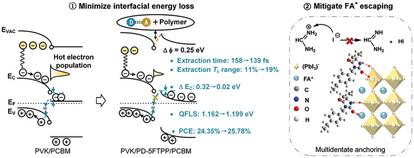当前位置:
X-MOL 学术
›
Adv. Mater.
›
论文详情
Our official English website, www.x-mol.net, welcomes your feedback! (Note: you will need to create a separate account there.)
Minimizing Interfacial Energy Loss and Volatilization of Formamidinium via Polymer‐Assisted D–A supramolecular Self‐Assembly Interface for Inverted Perovskite Solar Cells with 25.78% Efficiency
Advanced Materials ( IF 27.4 ) Pub Date : 2024-07-19 , DOI: 10.1002/adma.202404797 Congcong Tian 1 , Anxin Sun 1 , Rongshan Zhuang 1 , Yiting Zheng 1 , Xueyun Wu 1 , Beilin Ouyang 1 , Jiajun Du 1 , Ziyi Li 1 , Xiling Wu 1 , Jinling Chen 1 , Jingyu Cai 1 , Yong Hua 2 , Chun‐Chao Chen 1
Advanced Materials ( IF 27.4 ) Pub Date : 2024-07-19 , DOI: 10.1002/adma.202404797 Congcong Tian 1 , Anxin Sun 1 , Rongshan Zhuang 1 , Yiting Zheng 1 , Xueyun Wu 1 , Beilin Ouyang 1 , Jiajun Du 1 , Ziyi Li 1 , Xiling Wu 1 , Jinling Chen 1 , Jingyu Cai 1 , Yong Hua 2 , Chun‐Chao Chen 1
Affiliation

|
2D perovskite passivation strategies effectively reduce defect‐assisted carrier nonradiative recombination losses on the perovskite surface. Nonetheless, severe energy losses are causing by carrier thermalization, interfacial nonradiative recombination, and conduction band offset still persist at heterojunction perovskite/PCBM interfaces, which limits further performance enhancement of inverted heterojunction PSCs. Here, 5,10,15,20‐tetrakis(pentafluorophenyl)porphyrin (5FTPP) is introduced between 3D/2D perovskite heterojunction and PCBM. Compared to tetraphenylporphyrin without electron‐withdrawing fluoro‐substituents, 5FTPP can self‐assemble with PCBM at interface into donor–acceptor (D–A) complex with stronger supramolecular interaction and lower energy transfer losses. This rapid energy transfer from donor (5FTPP) to acceptor (PCBM) within femtosecond scale is demonstrated to enlarge hot carrier extraction rates and ranges, reducing thermalization losses. Furthermore, the incorporation of polystyrene derivative (PD) reinforces D–A interaction by inhibiting self‐π–π stacking of 5FTPP, while fine‐tuning conduction band offset and suppressing interfacial nonradiative recombination via Schottky barrier, dipole, and n‐doping. Notably, the multidentate anchoring of PD‐5FTPP with FA+ , Pb2+ , and I− mitigates the adverse effects of FA+ volatilization during thermal stress. Ultimately, devices with PD‐5FTPP achieve a power conversion efficiency of 25.78% (certified: 25.36%), maintaining over 90% of initial efficiency after 1000 h of continuous illumination at the maximum power point (65 °C) under ISOS‐L‐2 protocol.
中文翻译:

通过聚合物辅助 D-A 超分子自组装界面最大限度地减少甲脒的界面能量损失和挥发,实现倒置钙钛矿太阳能电池效率为 25.78%
二维钙钛矿钝化策略有效减少钙钛矿表面的缺陷辅助载流子非辐射复合损失。尽管如此,异质结钙钛矿/PCBM界面仍然存在载流子热化、界面非辐射复合和导带偏移造成的严重能量损失,这限制了倒置异质结PSC性能的进一步提高。在这里,5,10,15,20-四(五氟苯基)卟啉(5FTPP)被引入到3D/2D钙钛矿异质结和PCBM之间。与不含吸电子氟取代基的四苯基卟啉相比,5FTPP可以在界面处与PCBM自组装成供体-受体(D-A)复合物,具有更强的超分子相互作用和更低的能量转移损失。这种在飞秒尺度内从供体 (5FTPP) 到受体 (PCBM) 的快速能量转移被证明可以扩大热载流子提取率和范围,减少热化损失。此外,聚苯乙烯衍生物(PD)的掺入通过抑制5FTPP的自π-π堆积来增强D-A相互作用,同时微调导带偏移并通过肖特基势垒、偶极子和n掺杂抑制界面非辐射复合。值得注意的是,PD-5FTPP 与 FA+、Pb2+ 和 I− 的多齿锚定减轻了热应力期间 FA+ 挥发的不利影响。最终,采用 PD-5FTPP 的器件实现了 25.78% 的功率转换效率(认证:25.36%),在 ISOS-L- 下以最大功率点(65 °C)连续照明 1000 小时后,仍保持初始效率的 90% 以上。 2 协议。
更新日期:2024-07-19
中文翻译:

通过聚合物辅助 D-A 超分子自组装界面最大限度地减少甲脒的界面能量损失和挥发,实现倒置钙钛矿太阳能电池效率为 25.78%
二维钙钛矿钝化策略有效减少钙钛矿表面的缺陷辅助载流子非辐射复合损失。尽管如此,异质结钙钛矿/PCBM界面仍然存在载流子热化、界面非辐射复合和导带偏移造成的严重能量损失,这限制了倒置异质结PSC性能的进一步提高。在这里,5,10,15,20-四(五氟苯基)卟啉(5FTPP)被引入到3D/2D钙钛矿异质结和PCBM之间。与不含吸电子氟取代基的四苯基卟啉相比,5FTPP可以在界面处与PCBM自组装成供体-受体(D-A)复合物,具有更强的超分子相互作用和更低的能量转移损失。这种在飞秒尺度内从供体 (5FTPP) 到受体 (PCBM) 的快速能量转移被证明可以扩大热载流子提取率和范围,减少热化损失。此外,聚苯乙烯衍生物(PD)的掺入通过抑制5FTPP的自π-π堆积来增强D-A相互作用,同时微调导带偏移并通过肖特基势垒、偶极子和n掺杂抑制界面非辐射复合。值得注意的是,PD-5FTPP 与 FA+、Pb2+ 和 I− 的多齿锚定减轻了热应力期间 FA+ 挥发的不利影响。最终,采用 PD-5FTPP 的器件实现了 25.78% 的功率转换效率(认证:25.36%),在 ISOS-L- 下以最大功率点(65 °C)连续照明 1000 小时后,仍保持初始效率的 90% 以上。 2 协议。












































 京公网安备 11010802027423号
京公网安备 11010802027423号